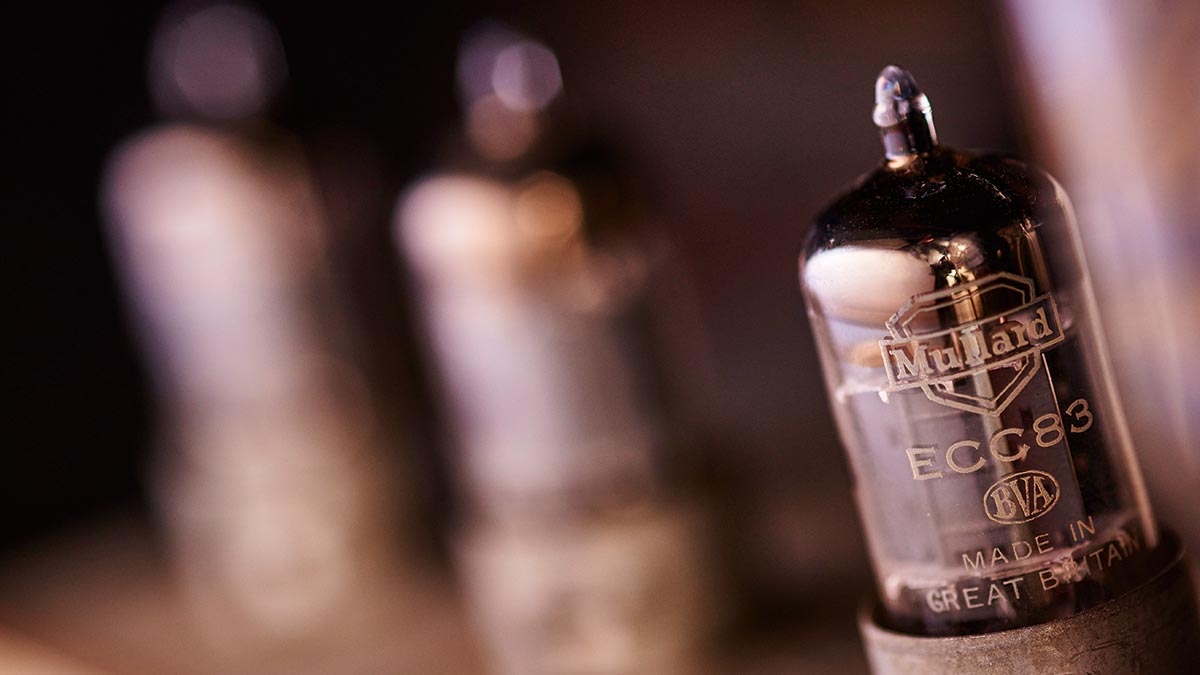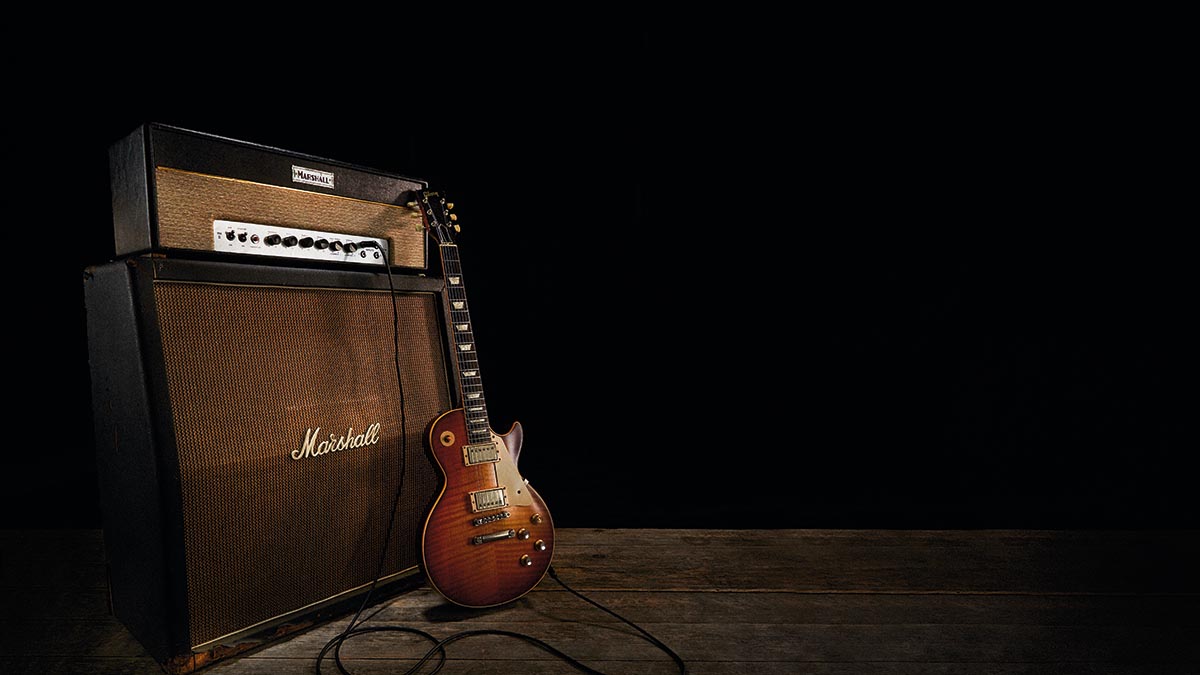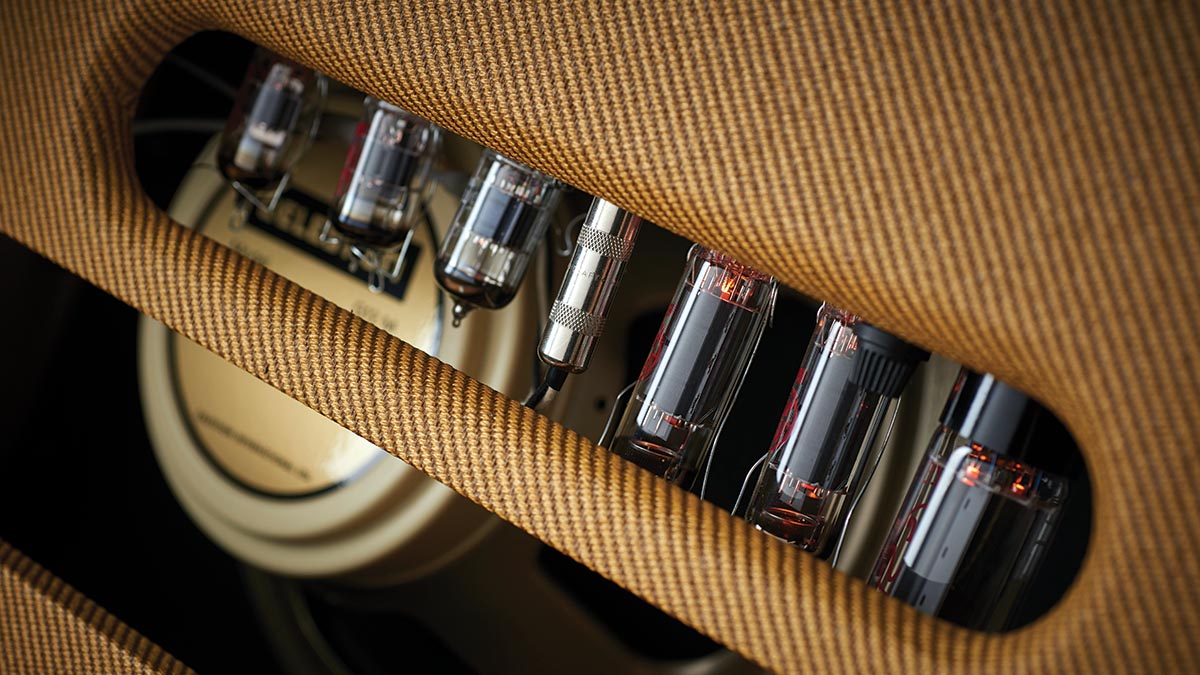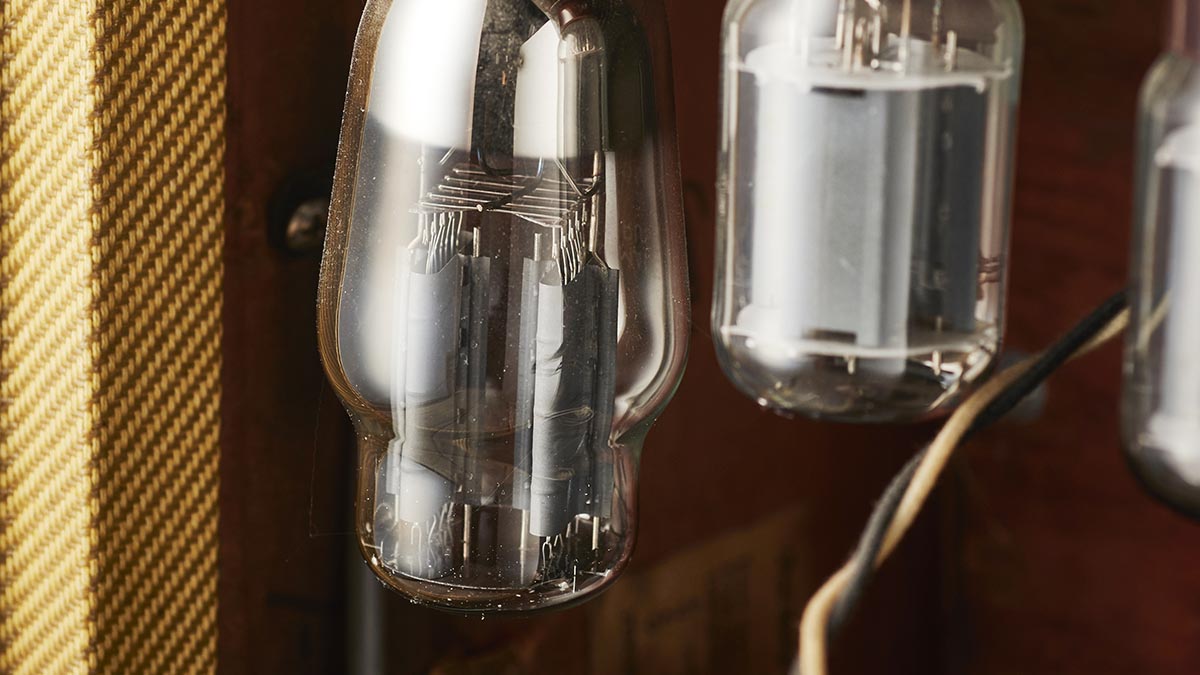
In previous decades, transistors offered guitarists cheaper and lighter amplifiers, and today digital amplifier modelling technology can achieve astonishing sound quality. But huge numbers of guitarists remain addicted to the bottle – or thermionic tube, if you prefer.
Thermionic tubes come in many forms and their names tell us how many working parts are contained within that glass or metal enclosure, not including the heater. The simplest form of tube is the diode, which only contains an anode and a cathode.
A heated cathode releases negatively charged electrons into the vacuum, hence the terms ‘thermionic emission’ and ‘thermionic valve’. With AC voltage from the power transformer connected between the anode (aka plate) and cathode, current flows through the tube when the AC is in its positive phase at the anode because it attracts the electrons. When the AC is in its negative phase, no electrons are attracted to the anode and no current flows.
With current flowing in one direction but not the other, diodes can be compared to non-return valves used in plumbing applications – and that’s how the name ‘valve’ came about. As a catch-all label, ‘valve’ has remained in use in the UK long after the introduction of triodes, tetrodes and pentodes rendered it inaccurate and inappropriate. In the US, the preferred term is ‘tube’.
Diode tubes can be found in guitar amps and they’re called rectifiers. They’re used in the power supply as the first stage in converting AC to DC, but many later designs employ solid-state diodes rather than tube rectification. Diodes tubes are not used in amplifier preamps, but the anode/cathode arrangement helps us understand how preamp tubes work.

Triodes
Triodes are the tubes most often found in the preamp section of a guitar amp and, like diodes, a triode employs an anode and a cathode. The added element is a control grid, which can be considered the ‘audio input’.
Amplifier power supply stages convert the AC (alternating current) coming out of a wall socket into DC (direct current). In simplified terms, the rectified HT supply is connected to the anode and the cathode connects to ground. Voltage is also applied to the heater, usually 6.3 volts AC but sometimes 12 volts DC to minimise noise.
Get The Pick Newsletter
All the latest guitar news, interviews, lessons, reviews, deals and more, direct to your inbox!
The primary purpose of a triode tube – and indeed the amplifier itself – is to increase the amplitude of the input signal
Since the anode is always positively charged and the cathode is always negative, direct current flows through the tube. This is called the ‘idle current’, much like the idle revs on your car engine when you’re waiting for the lights to go green. The interesting stuff starts happening when the alternating current generated by a guitar pickup is connected to the control grid.
An alternating current has positive and negative phases, which causes the grid to vary between positive and negative charge accordingly. When positively charged, the grid ensures a greater number of electrons reach the anode, so current flow through the tube increases.
But when the control grid becomes negatively charged, this means that fewer electrons reach the anode and current flow drops. In short, direct current flowing through the tube becomes an alternating current when guitar signal appears on the control grid.

Having said all that, the primary purpose of a triode tube – and indeed the amplifier itself – is to increase the amplitude of the input signal. In order to achieve that, two external components are required. A resistor is connected between the HT voltage supply and the plate, with a ‘bias’ resistor between the cathode and ground to control the current flowing through the tube.
We won’t get into the complex subject of bias setting and gain manipulation here. For amplification purposes, the plate resistor will be larger than the bias resistor, with typical values being 100k/1.5k (Fender), 100k/820R (Marshall) and 220k/2.2k (Vox).
The guitar signal appearing at the control grid is measured in millivolts, but the voltage at the anode can exceed 200 volts. As the current flowing through the tube alternates, so does the voltage across the plate resistor. The wavelength and frequency of the alternating voltage at the anode will be identical to the guitar signal, but amplitude is far greater. In a nutshell, that’s amplification.

Pentodes
When gain is set beyond the capability of a triode, capacitance between the plate and the control grid can cause oscillation. This is known as the Miller Effect, and to overcome it tube designers introduced a screen grid between the anode and control grid. When positively charged at a voltage lower than the anode, the grid acts as an electrostatic shield.
Pentodes are more efficient than triodes and are capable of far higher gain, but they can prove noisy and unreliable in guitar amps
But the resulting tetrode tube can have issues, too, because electrons hitting the anode at higher velocity may cause additional electrons to be emitted from the anode itself. This is called secondary emission and when these unwanted electrons are attracted to the screen grid, there’s a loss of plate current and amplification is lower than it should be.
As a consequence, tetrode preamp tubes aren’t used in guitar amps, but pentodes are. Pentodes have a third grid located between the screen grid and the anode. This is called a ‘suppressor grid’ and it is connected to the cathode – and because it’s negatively charged it bounces secondary emissions back to the anode.
With an anode, cathode, control grid, screen grid and a suppressor grid, a pentode has five component parts – hence the name. Pentodes are more efficient than triodes and are capable of far higher gain, but they can prove noisy and unreliable in guitar amps.
Octal Triodes
Prior to the mid-50s, most guitar amps had octal preamp triodes. They can be easily mistaken for small power tubes because they look much like 6V6s and plug into the same style eight-pin sockets – again, hence the name. The most common are the 6SC7, 6SN7 and the 6SL7 found in early Fender tweeds, various Gibson GA models and Ampegs. All are dual triode tubes, housing electronically independent triodes with a shared heater.
Fender’s way of configuring octal triodes back in the early days of the V-Front Super and Dual Professional and TV Front Pro brought out a smooth, fat and dirty grind that’s perfect for raw blues and classic ZZ Top tones
These types of tubes provide decent gain – especially the 6SC7 and 6SL7 types – and they combine full-bodied midrange tones with sweet treble. Hi-fi enthusiasts appreciate their clarity and they’re ideally suited to old-school jazz guitar tones.
But Fender’s way of configuring them back in the early days of the V-Front Super and Dual Professional and TV Front Pro brought out a smooth, fat and dirty grind that’s perfect for raw blues and classic ZZ Top tones. When heavily overdriven, they’re also pleasingly devoid of the edgy fizz of some later amp designs.
Most of the common variants remain in production and new-old-stock examples are widely available. Unfortunately, both are prone to microphonics and you’re usually better off buying from a reputable tube supplier who can test the tubes prior to dispatch and offer a warranty.
Mini Triodes
These are the dual-triode preamp tubes most of us will be familiar with. Requiring smaller nine-pin sockets, the most commonly used examples include the ECC83, 7025, 12AX7, ECC81, ECC82 and 12AY7.
Although they all have different gain characteristics, most are interchangeable, but sonic performance may be compromised without tweaking the circuit for that specific tube. The ECC88 is an exception because its pin connections are arranged differently.
The 12AX7/ECC83 – and the ‘low noise’ equivalent, the 7025 – is by far the most common preamp tube for guitar amps, and with a gain factor around 100, it’s ideal for the job.
When Fender tweed amps transitioned to mini triodes, the 12AY7/6072 was preferred for V1. With a gain factor around 44, the 12AY7 has a clear and open tone and the amp will run cleaner. Since most tweed fans are in it for the overdrive, replacing a 12AY7 with a 12AX7/ECC83/7025 will make an amp livelier and quicker to distort.
If a gain factor of 100 sounds too hot, a 5751 (aka 12AT7) can provide a nice halfway point with a gain factor of 70. The 5751 is a great-sounding plug-and-play replacement for a 12AX7. The ECC81/12AT7 has a gain factor of about 60, but it can sound a bit bland and more often shows up in phase inverter or reverb driver applications.
The ECC82/12AU7 has a gain factor of just 20, so it’s unsuitable for guitar preamp duties. However, it works well in phase inverters where no gain is required and can be used for effects loop buffering.
The Power Of Pentodes
In contrast to double triodes, pentode tubes contain individual units and you can’t replace a triode with a pentode because the pin connections differ. Although less common in guitar amps, the clarity and brightness of pentodes are desirable characteristics for guitar amps. They also produce significantly higher levels of gain than any single triode.
Pentodes have a long history in guitar amps. Octal versions such as the 6J7 featured in the earliest tweed Fender Champs and Gibson’s EH-185 and BR-6
Pentodes have a long history in guitar amps. Octal versions such as the 6J7 featured in the earliest tweed Fender Champs and Gibson’s EH-185 and BR-6.
Later nine-pin mini pentodes such as the EF86 can be found in early Vox AC30s, AC15s and AC10s, as well as Vox-inspired modern amps made by Matchless, TopHat, Dr Z and 65. Another mini pentode called the 5879 was used in 1950s Gibson amps, like the wonderful GA40.
There are also oddball tubes such as the ECF82 found in original Vox AC10s, which combine a triode and a pentode in a single glass enclosure. But just like regular pentodes, the big issue is finding examples that are non-microphonic and will stay non-microphonic.
The ringing and squealing can be especially problematic at high volume, and amp manufacturers try to alleviate the problem by mounting pentode sockets on rubber spacers and placing dampener rings around the glass.
Well, that’s about it for preamp tubes, but no doubt we’ll be taking a close look at power tubes very soon…
Huw started out in recording studios, working as a sound engineer and producer for David Bowie, Primal Scream, Ian Dury, Fad Gadget, My Bloody Valentine, Cardinal Black and many others. His book, Recording Guitar & Bass, was published in 2002 and a freelance career in journalism soon followed. He has written reviews, interviews, workshop and technical articles for Guitarist, Guitar Magazine, Guitar Player, Acoustic Magazine, Guitar Buyer and Music Tech. He has also contributed to several books, including The Tube Amp Book by Aspen Pittman. Huw builds and maintains guitars and amplifiers for clients, and specializes in vintage restoration. He provides consultancy services for equipment manufacturers and can, occasionally, be lured back into the studio.
"I never use my tube amp at home now, because I have a Spark Live": 5 reasons you should be picking up the Positive Grid Spark Live in the massive Guitar Month sale
“Our goal is to stay at the forefront of amplification innovation”: How Seymour Duncan set out to create the ultimate bass amp solution by pushing its PowerStage lineup to greater heights




![A black-and-white action shot of Sergeant Thunderhoof perform live: [from left] Mark Sayer, Dan Flitcroft, Jim Camp and Josh Gallop](https://cdn.mos.cms.futurecdn.net/am3UhJbsxAE239XRRZ8zC8.jpg)









